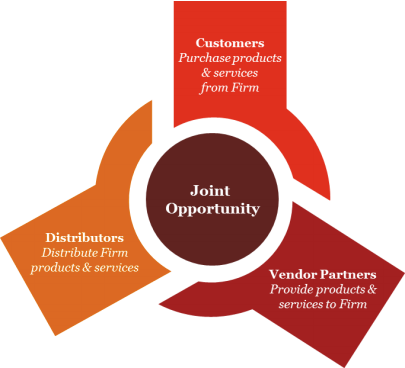Customers, distributors and vendors sink or swim together. One-sided relationships that maximize value for only one partner are self-defeating. They often result in the dissolution of worthwhile relationships, including the loss of key customers and the inability to access meaningful new opportunities.
Despite this, when it comes to managing relationships with vendors, distributors and customers, most companies set the bar low, and it shows during the annual planning process. Plans typically call for negotiating better rates with vendors and distributors. We often hear, “We’ll negotiate better rates and cut costs this year by one to two percent.” Or, “We'll do more for customers and hope to increase our share of their wallet.” Or, sometimes even, “We just hope to retain the business.”
In addition to near-term planning, most organizations have traditionally managed important vendor, distributor and customer relationships through various business functions, including procurement, treasury, IT, sales and distribution, product and account management. In many cases, these functions are split by territory or division — and often even further by business line. As a result, organizations tend to manage these critical relationships in silos, quarter to quarter, seeking to maintain or marginally improve the partnerships currently in place.
Moreover, as many organizations look to expand beyond their existing footprint to increase scale, introduce innovative products and offer customers and partners engaging experiences, they often create even more silos that hurt relationships with new vendors, distributors and customers.
From a tactical approach to a strategic one
The status quo is far from ideal, and many companies are beginning to realize that successfully deploying their relationship capital can provide a significant boost to long-term revenue and profitability prospects.
Unlike traditional, siloed vendor, distributor and customer relationship management functions,
strategic relationship management (SRM) views vendor, distributor and customer relationships holistically (e.g., from each perspective) and allows organizations to not only improve the terms of these relationships but also radically re-imagine them by developing new partnership models. SRM also enables organizations to streamline their total vendor and distributor footprint by focusing strategic spending on a few core partnerships.
Certain industries are rapidly adopting SRM to unlock the full value of their partnerships. The financial services, technology and professional services industries are early adopters, and we anticipate broader industry adoption as firms increasingly see their vendors, distributors and customers as strategic partners. Early adopters have begun viewing their strategic relationships as assets, with the objective of increasing long-term shared value for all parties.
See also: A New Paradigm for Risk Management?
Organizations that have adopted SRM have seen tangible benefits from being in the cockpit with their most strategic partners. Organizations with SRM invest in partnerships by creating shared business plans and meeting regularly to discuss joint activities and coming opportunities. Enterprises and their top strategic partners have come to realize that they sink or swim together, and they focus on developing truly mutually beneficial relationships.

Examples of strategic partnership models include:
- An insurer strikes a strategic partnership with a vendor. A global life insurer used several vendors to assist it with various strategic initiatives. Through its SRM function, the organization was able to prioritize one of the vendor firms that had a strong track record of helping the organization. Through several joint strategic partnership meetings, the two organizations defined a partnership model that could help drive shared, long-term objectives. The life insurer agreed to partner with the vendor on several strategic growth initiatives in return for taking over the vendor’s group life insurance plan (for 50,000-plus employees).
- A strategic customer provides product feedback that increases sales and customer satisfaction. A large technology company had prioritized strategic customer accounts throughout its entire organization. By cultivating these relationships at all levels, the sales and distribution and account management teams were able to quickly relay real-time customer feedback to the product group. This transparency enabled the technology organization to make quick changes to its product offering that significantly increased sales, customer retention and satisfaction upon full product launch.
- A partner opens the door to new markets. A regional bank used its SRM function as a foothold to expand its operations into new markets. The bank leveraged its strategic B2B partnerships, which already had operational or commercial reach, into select target markets that the bank selected based on the partners’ access to distribution channels and other opportunities to accelerate growth.
- A large coffee retailer identifies a “win-win” opportunity with a strategic coffee supplier. Through its SRM function, a multinational coffee retailer identified a strategic partnership with one of its coffee suppliers in South America. The supplier produced top-quality Arabica coffee and needed to expand to meet the coffee retailer’s growing demands. Knowing the strategic importance of the relationship in the long term, the SRM function worked with the executive leadership team to create a mutually beneficial opportunity. The coffee retailer helped fund part of a coffee farm expansion project, and the supplier agreed to sell its product to the only retailer and work with it to develop new coffee blends. The retailer was able to build a strategic partnership that is helping to fuel its long-term growth strategy, while the coffee supplier was able to also grow its farming output.
Strategic Relationship Management approach
SRM strategically influences the lifecycle of major opportunities by focusing on four key concepts: connect, collaborate, leverage and influence.
Connect with your vendors, distributors and customers to identify their needs and develop strategies to successfully meet them.
Leverage strategic relationships to identify and prioritize growth opportunities.
Collaborate among business units, across borders and with external account stakeholders to create awareness of new opportunities.
Influence decisions where possible to increase benefits and drive growth for your customers and company.
This approach can help organizations develop joint strategies with their strategic partners to uncover mutually beneficial opportunities and create shared value. Selecting the accounts deemed “strategic” is one of the foundational aspects of setting up SRM, and companies must carefully establish the baseline criteria and other factors they’ll use to identify these accounts.
In addition, to obtain its full benefits, cross-functional executive leadership buy-in is essential to establishing effective SRM. An internal executive governance committee as well as appropriate account management processes and technology platforms will be necessary for the entire organization to effectively own and manage the targeted strategic accounts.
Conclusion: Benefits of Strategic Relationship Management
In conclusion, any organization can benefit from implementing SRM to strategically manage its most vital partnerships. Because of their scale and increased complexity, multinational organizations can stand to benefit exponentially.
Benefits for enterprise:
- Leverage partners’ skills, capabilities and specialized knowledge as your own
- Gain access to partners’ networks, channels and geographies
- Create opportunities to evaluate a relationship holistically (i.e., as a buyer, vendor and distributor)
- Lower negotiated rates with suppliers by negotiating across business units/divisions/ geographies
- Improve revenue, margin expansion and prioritization of vendor and distributor relationships
- Simplify relationships with fewer vendors and distributors
Benefits for strategic partners:
- SRM-sponsored symposiums where buyers and vendors define common goals
- Executive group partnership that incorporates global, regional and local perspectives
- Candid and active feedback on final decisions (win or lose) within defined timelines
- B2B business planning
- Awareness of RFP opportunities
In short, having deeper and more meaningful partnerships with strategic partners creates transparency, trust and, subsequently, more opportunities for all parties. Moreover, the proper functions will clearly hear the voice of vendors, distributors and customers and thereby facilitate mutually beneficial, active strategic decision making.
See also: A Revolution in Risk Management
This post was written with John Dixon, Jay Kaduson and Tucker Matheson. Examples of strategic partnership models include:
Examples of strategic partnership models include:







